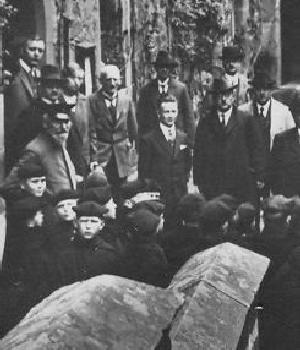
German Boy Choir Costumes: Eisenach Kurrende Boys Choir

Figure 1.-- We note a post card labeled Eisenach Vorderer Wartburghof Die Kurrende v.d. Publlkum Im Wartburghof. Eisenach was the location. The photograph was taken in front of Wartburghof--a historic castle. The Wartburghof is one of the most famous castles in Germany. It was here Luther hid from the Emperor and Counter Reformation. The choir, however, was probably not assiciated with the castle. Kurrende was a boys' choir. The boys were often from poor families and recruited to sing spiritual songs at religious events. The boys seem to be wearing medieval-style caps and cloaks. The photograph was a post card that looks to have been mailed about 1930.
|
|
We note a post card labeled Eisenach Vorderer Wartburghof Die Kurrende v.d. Publlkum Im Wartburghof. Eisenach was the location. The photograph was taken in front of Wartburghof--a historic castle. The Wartburghof is one of the most famous castles in Germany. It was here Luther hid from the Emperor and Counter Reformation. The choir, however, was probably not assiciated with the castle. Kurrende was a boys' choir. The boys were often from poor families and recruited to sing spiritual songs at religious events. The boys seem to be wearing medieval-style caps and cloaks. The photograph was a post card that looks to have been mailed about 1930 to America.
Eisenach
Eisenach was a sleepy little town on the northwestern slopes of the Thuringian Forest, about 50 kilometers west of Erfurt. The medieval charm of the town ended when the East German Government made Eisenach the center of the East German automobile industry. They even produced a car nameed the Wartburg. The town is best known for its imposing medieval castle--the Wartburg. Half-timbered houses ring the ancient market square. Most visitors to Eisenach are interest in the Wartburghof and Martin Luther. Johann Sebastian Bach was born in Eisenach. He wrote many hymns and cantatas the boys would sing.
Wartburg Castle
The choir was photographed in the court in front of the Wartburg Castle. The Wartburg is a very famous castle near Eisenach. Martin Luther first lived in the town at the Lutherhaus and later in disguise as "Knight George" in the Wartburghof. Here he was pritecred from the Emperor and the Counter Reformation (16th century). Here he translated translated the Bible into German. This was a major step in the Protestant Reformation and a milestone in the development of the German language. The Catholic Church opposed translating the Bible and publishinging it in the developing vernacular national languages. Several early reformers were burned at the stake for this offense. The Catholic Church did not believe the average person could handel the Bible and the clergy wanted to reserve its mysteries for themselves as a kind of job security. Protestants on the other hand promoted Bible reading. Books even after printing was developed were expensive, but one book most Protestant families had in the home was the Bible.
The Wartburg is a castle. The Wartburghof is part of the castle. A hof is a court(yard) in German. The Wartburg castle has several hofs. The one we are mentioning here is the Hof in the front of the Wartburg. They have one in the back too and perhaps several on the sides. Luther worked and lived in the Wartburg itself, but I am sure that he went out of his room to smoke in the hof.
"Kurrende" is an old German word. It was a special boys choir, established in the Middle Ages. The boys were often from poor families and recruited to sing spiritual songs at religious events. The boys sang in the days before recorded music was instantly available in homes. They were mobile and thus could bring music to where it was needed. They sang in front of houses, at funerals, and other events for money. Today it is just a name used for Protestant boys choirs.
The Choir
The boys are wearing medieval-style caps and cloaks. We do not know just when this choir was founded, but the design of their costumes may date back centuries. The photograph was a post card that looks to have been mailed about 1930 to America. Presumably a tourist visiting the Wartburghof mailed it. The Choir does not appear to be associated with the Wartburghof. They were visiting or performing there.
HBC

Navigate the Historic Boys' Clothing Web Site:
[Introduction]
[Activities]
[Biographies]
[Chronologies]
[Countries]
[Essays]
[Style Index]
[Theatricals]
[Bibliographies]
[Contributions]
[FAQs]
[German glossary]
[Images]
[Links]
[Registration]
[Boys' Clothing Home]
Navigate the Historic Boys' Clothing Web choir costume pages:
[Return to the Main Individual German choir page]
[Return to the Main national choir page]
[Australia]
[Austria]
[Belgium]
[Bulgaria]
[Canada]
[Denmark]
[England]
[France]
[Finland]
[Germany]
[Japan]
[Netherlands]
[Poland]
[South Africa]
[United States]
Navigate the Historic Boys' Clothing Web style pages:
[Short pants suits]
[Blazers]
[Collars]
[Lace collars]
[Ruffled collars]
[Eton collar]
[Fauntleroy suits]
[Sailor suits]
[Ring bearer/page costumes]
[First Communion suits]
Created: 4:11 AM 6/23/2009
Last updated: 8:23 PM 6/23/2009



